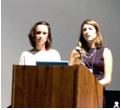

Rebecca Post ’14 and Stephanie Miller ’14 were invited to present their research as part of the Young Researchers in Developmental Psychology symposium at the annual meeting of the American Psychological Association in Honolulu, HI, this August. They were the only undergraduates at the convention to receive this honor, with the other four papers in the symposium presented by graduate and post-graduate students. Their research, carried out under the supervision of Nancy Rader, Psychology, found that attention, as measured by pupil dilation, is orchestrated by gestures that caregivers use when they talk to their infants. A summary of the research is presented below:
Inside the Infant Mind: Pupil Dilation Reveals Attention Processing in Early Word Learning
Rebecca Post, Stephanie Miller, & Nancy Rader, Ph.D.
Research presented at the APA Annual Convention, Honolulu, HI, August 2013
Communication is vital to forming successful relationships within society. As humans, we tend to use our hands and other gestures to communicate. This idea of using gestures while talking is common in our conversations and interactions with children from infancy to early childhood. Caregivers have been shown to use a gesture in introducing words for objects to infants that involves moving the object in synchrony with the speech. However, it has not been known to what extent using this gesture affects infant word learning.
To study the effects of movement per se and the importance of synchrony, our research group designed a study to compare three types of gestures. One is a static gesture in which a person holds an object still while talking about it. Another is known as a dynamic, asynchronous gesture, in which a person talks about an object but does not move the object in synchrony with their speech. The third gesture we studied is the show gesture, which involves the speaker talking about the object while simultaneously moving it. Past research in our lab has found that this show gesture leads to word learning, while the other two types of gesture do not. In the study we are reporting on here, we used pupil dilation as a measure of attention to determine whether the effect of the show gesture on word learning was due to enhanced attentional processing, and whether any changes in attentional arousal was due to the synchrony of the show gesture.
We hypothesized the show gesture, as compared to the static or asynchronous gestures, would produce the greatest increase in pupil dilation at the time the word for the object was uttered. We also planned to examine the extent to which hearing the word, seeing the gesture, or the synchrony of hearing and seeing was driving the pupil size changes. And, finally, we hypothesized that increased pupil diameter would correlate with better word learning.
At Ithaca College, we are very fortunate to have special eye-tracking equipment in our lab that allows us to track infant eye gaze and measure pupil diameter across events in a video. In this research, we studied infant between the ages of 9.0 to 14.7 months, looking at the effects of three separate gestures on pupil dilation. All infants came from an upstate New York area surrounding Ithaca College, and came from primarily English speaking homes. Participants were recruited through birth notices, friends, associates children at the College, going to day-care centers, etc. Once infants were brought in for testing, they were seated in a car seat facing a large plasma screen T.V. The experimenter attached a head sensor on the baby above the right eye so that the experimenter working the computer in the back room could track the head of the baby. Once the baby was settled and content with the head sensor on (sometime they ripped it off), they began watching a video segment where a speaker presented two novel objects (objects they had never seen before) paired with nonce words (words they had never heard before) in the context of infant directed speech. The videos were created through digital editing such that they were identical except for the gesture used.
Each infant was randomly assigned to one of two studies upon arrival. Study 1 had the speaker use a show gesture and a static gesture within the video segment, while in Study 2 the speaker used a show gesture and an asynchronous gesture. We made sure that counterbalancing was used for the ordering of the gesture conditions and objects used in each condition.
We found that for both studies, pupil size increased from before the speaker said the word to while the word was being said for the show gesture condition but not in the static or asynchronous gesture conditions. We also found a significant positive correlation (relationship) between the infants’ word learning scores and pupil size change in the show gesture condition. In other words, greater pupil dilation as the word for the object was uttered, the better the infant learned the word.
Overall, the pupil dilation increases that we found reveal that a show gesture produces greater attentional processing ONLY at the time the infant is most likely to be looking at the object AND hearing the word for the object at the same time. In other words, the show gesture functions not only to bring eye gaze to the object as the word is being said, but also functions to enhance attention as the eye gaze to object and the object’s word co-occur. The captured attention created by the show gesture provides an opportunity for linking a word to an object and ultimately early word learning in infants.
https://www.ithaca.edu/intercom/article.php/20130827115149220